MARK BANDO'S WEBSITE
101st Patches-Vietnam War Era
When the 101st Division's First Brigade deployed to Nam in 1965, they were all wearing full color, U.S. made patches with raw edges, of WW2 type manufacture. When the rest of the division deployed in 1967's Operation Eagle Thrust, the troops were still wearing
the same traditional type patches. However sometime around 1968, patches of a design style similar to WW2 Type 14, but with Merrowed Edges, were introduced. While still fully-embroidered and in full-color, these patches had a thick cord around the edges of both the tab and shield.
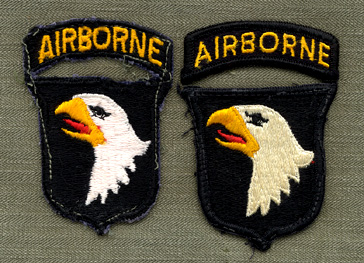 The patch above left is a scribble eye of WW2 style manufacture, worn during Eagle Thrust in 1967. The one at right is the merrowed edge type introduced in 1968 and in use for 25 years thereafter. The design, especially eye details suggest they are made by the same company which made Type 14 during WW2.Note the thick edging on the merrowed edge patch and the resulting larger size of both tab and shield.
The patch above left is a scribble eye of WW2 style manufacture, worn during Eagle Thrust in 1967. The one at right is the merrowed edge type introduced in 1968 and in use for 25 years thereafter. The design, especially eye details suggest they are made by the same company which made Type 14 during WW2.Note the thick edging on the merrowed edge patch and the resulting larger size of both tab and shield.
Gook-Made, In-Country Patches
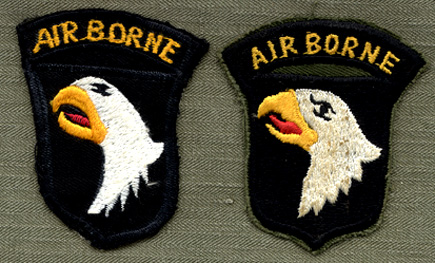 As the war dragged on into the 1972 period, 101st troops supplemented the U.S.-made, issued patches with locally- made eagle patches. The two styles shown above are Types which
were manufactured in great numbers, probably by the same two companies in South Vietnam, over a period of 4-5 years.
As the war dragged on into the 1972 period, 101st troops supplemented the U.S.-made, issued patches with locally- made eagle patches. The two styles shown above are Types which
were manufactured in great numbers, probably by the same two companies in South Vietnam, over a period of 4-5 years.
At left Type TMN1, which I call the "Sorry About That" patch, featured cotton embroidery on a base of black twill. The example shown has Vietnamese newspaper glued to the reverse side and the stitching runs clear through the paper. The patch at right is Type TMN2, which I've heard Fred Ranck of the 327th refer to as the 'Phan Rang Eagle'. It is possible that this design was first made in Tailor shops at that coastal location, but likely that patches of this design continued to be made at Phu Bai, when the division moved north into I Corps.
Both of these patches are of one-piece construction, with the design embrodered onto a single piece of cutout twill. The Type TMN2 is embroidered on green twill, such as fatigue shirts and trousers were cut from.
I've encountered several size variations of Type TMN2, but little variance in the Type TMN1.
Both styles were sometimes used in 'pocket hangers', encased in climate-protective plastic, with a leather tab above. The tab has a vertical slit in it, enabling the patch to be attached to the button of the left chest pocket of the khaki shirt, for Base Camp, or in-town wear. These two types are undoubtedly the most common theatre Made eagle patches of the Nam era.
Aside from the 2 Types shown above, there is a potentially infinite variety of other in-country designs. As E-5 Mike Stelmack (2/327th) told me in 1970:"All those variations don't mean anything. Just that some gook got it in his head to make the eagle look like a chicken, or whatever else he was inclined to do on any given day." I've since been informed that most of the tailors in those shops were of Korean descent-but then to some guys, 'a Gook is a Gook'.
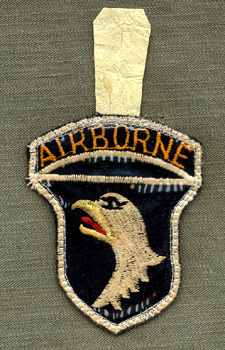 Although of unusual design, unlike the common patches usually seen in pocket hangers, this example shows how they were assembled. The patch is fully covered with plastic, and the leather tab at the top is for attaching to a shirt pocket button. The original owner of this patch, E-5 Ralph Johnson, 501 Airborne Infantry, of Tiffin, OH, passed away less than 20 years after the war ended, from Lukemia. It is possible that his exposure to defoliants like 'Agent Orange' may have contributed to his death.
Although of unusual design, unlike the common patches usually seen in pocket hangers, this example shows how they were assembled. The patch is fully covered with plastic, and the leather tab at the top is for attaching to a shirt pocket button. The original owner of this patch, E-5 Ralph Johnson, 501 Airborne Infantry, of Tiffin, OH, passed away less than 20 years after the war ended, from Lukemia. It is possible that his exposure to defoliants like 'Agent Orange' may have contributed to his death.
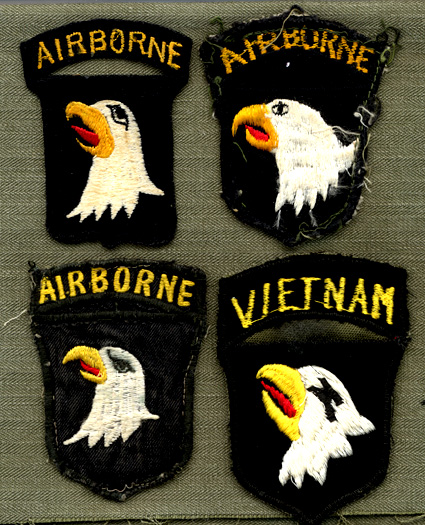 Above are four 68-72 vintage examples of the endless varieties of Theatre Made Nam patches. some bear a substitute for the word Airborne on the tab, such as 'Vietnam' or 'Cam Ranh Bay'.
Above are four 68-72 vintage examples of the endless varieties of Theatre Made Nam patches. some bear a substitute for the word Airborne on the tab, such as 'Vietnam' or 'Cam Ranh Bay'.
Theatre Made in Nam-Last Year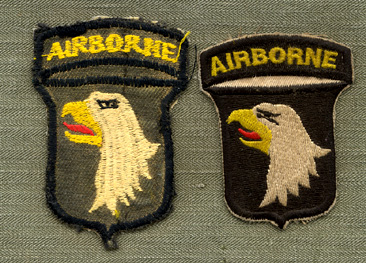 Bear in mind that many new in-county Nam-made eagle patches are still being turned out by locals in So. Vietnam, for a patch dealer in Paris. These have been introduced into collector shows in the states, but so far have been sold for about 1/3 the price charged for vintage era originals, made in the 1968-72 period. The trouble is, it is difficult if not impossible to determine when a given Nam-made patch was manufactured. Veteran provenance is once again the best and only reliable means.
Bear in mind that many new in-county Nam-made eagle patches are still being turned out by locals in So. Vietnam, for a patch dealer in Paris. These have been introduced into collector shows in the states, but so far have been sold for about 1/3 the price charged for vintage era originals, made in the 1968-72 period. The trouble is, it is difficult if not impossible to determine when a given Nam-made patch was manufactured. Veteran provenance is once again the best and only reliable means.
Subdued Patches
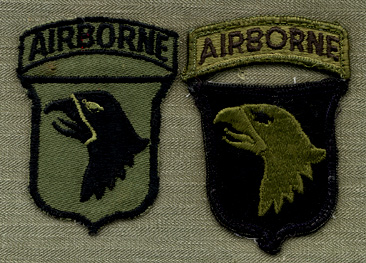 Mass produced black on green eagle patches as shown at left, were made available but not worn by troops in Nam. The wearing of subdued 101st SSI was against divisional policy during that war. The example shown, according to an ASMIC authority, was part of a series professionally manufactured in Japan circa 1969, which included all divisions serving in Nam at the time. I know that an almost exact copy is being turned out currently for the Paris dealer mentioned previously.
Mass produced black on green eagle patches as shown at left, were made available but not worn by troops in Nam. The wearing of subdued 101st SSI was against divisional policy during that war. The example shown, according to an ASMIC authority, was part of a series professionally manufactured in Japan circa 1969, which included all divisions serving in Nam at the time. I know that an almost exact copy is being turned out currently for the Paris dealer mentioned previously.
The subdued green and black patch shown at right first appeared in the early 1970's and features a merrowed edge. These patches were also not worn in Nam, but became a mainstay on field jackets and BDUs at Ft Campbell in the years after Nam. They were mistakenly used by actors in the film 'Hamburger Hill' because the technical advisors on that project fell down on the job (especially the full color 1965 era markings on UH-1 helicopters depicting a May 1969 battle). In the 1990's a brown and tan merrowed edge patch was introduced for desert warfare.
Novelty Patches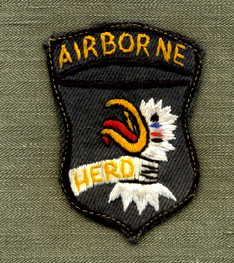 Starting in 1968, the 101st began receiving "Legs"(non jump-qualified infantry replacements), which continued, until by 1970-71, the composition of the division had been considerably changed. Members of the 82nd ABD and 173rd Brigade, still solidly on jump status, felt entitled to scorn the 'Screaming Chickens'.
Starting in 1968, the 101st began receiving "Legs"(non jump-qualified infantry replacements), which continued, until by 1970-71, the composition of the division had been considerably changed. Members of the 82nd ABD and 173rd Brigade, still solidly on jump status, felt entitled to scorn the 'Screaming Chickens'.
Around 1970-71, a novelty item known as the 'Choke Chicken' patch, began to appear, as shown above. The ones I've seen show either an 82nd patch or the word 'Herd', symbolizing the 173rd on the arm doing the choking. These novelty items were made and sold in Phu Bai, and some 101st men purchased them for laughs. In ensuing years, these patches have become quite scarce. The example shown was made recently for the French dealer alluded to earlier. Other
examples, thicker and cruder in design, have been made in Japan since the Nam war ended.
Currently (2013) Worn in Afghanistan
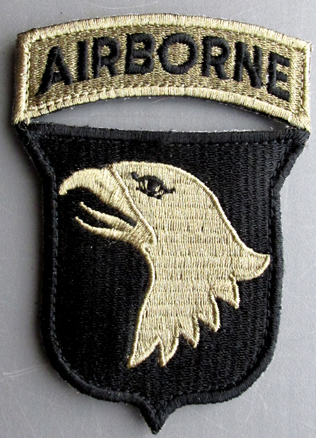 The latest incarnation of the screaming eagle SSI is GOLD in color and is
a descendant of the WW2 Type 14, with a merrowed edge. These are worn only with OEFCUs (multi cam) uniform, which in turn,
is currently worn only while deployed to Afghanistan.
The latest incarnation of the screaming eagle SSI is GOLD in color and is
a descendant of the WW2 Type 14, with a merrowed edge. These are worn only with OEFCUs (multi cam) uniform, which in turn,
is currently worn only while deployed to Afghanistan.
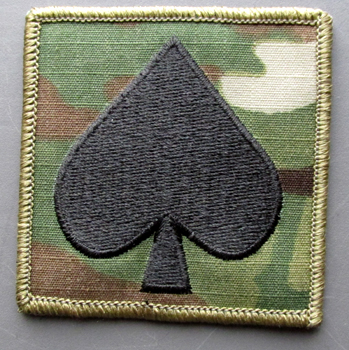 Sub-unit Helmet identification markings are still playing card symbols,
based on the system initiated during WW2. This one is a spade for the 506th IN and is worn on both sides of a multi cam
helmet cover.
Sub-unit Helmet identification markings are still playing card symbols,
based on the system initiated during WW2. This one is a spade for the 506th IN and is worn on both sides of a multi cam
helmet cover.
-All photos and information in Eagle Patch Corner, Copyright Mark Bando, September 2000.












